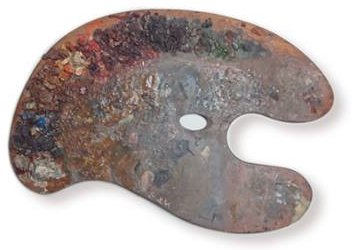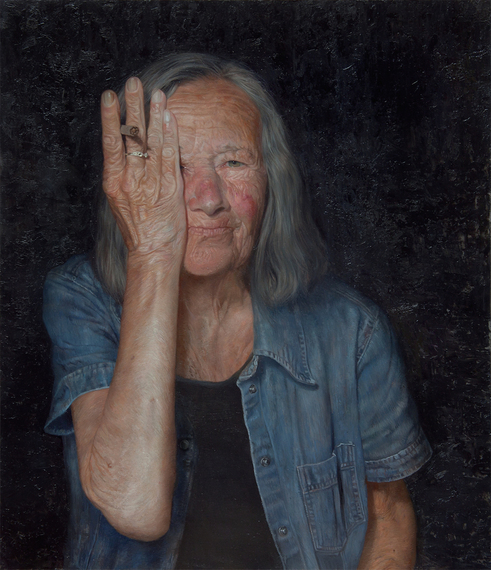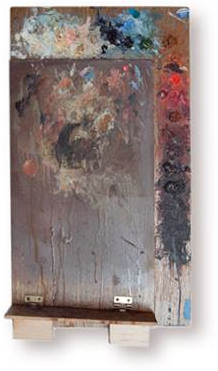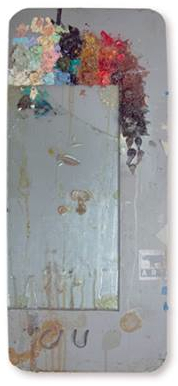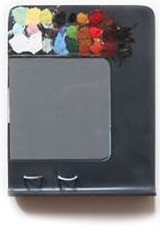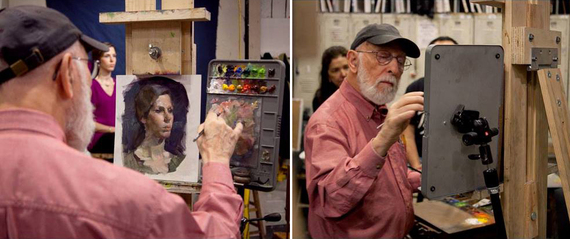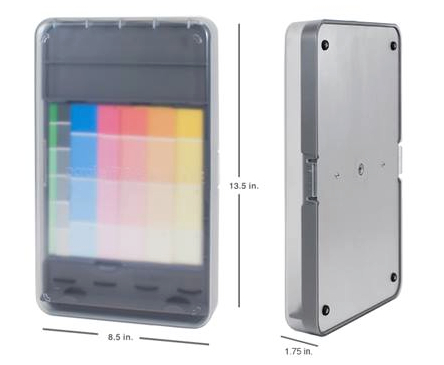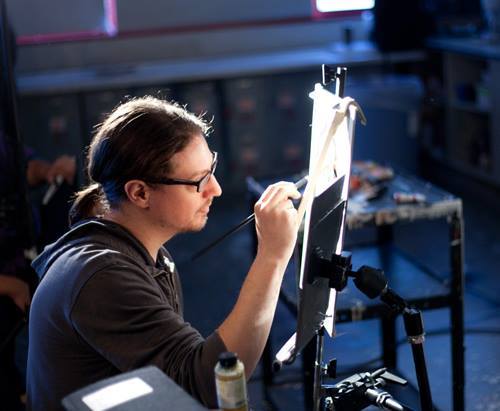"I'm a very pragmatic guy," painter David Kassan says, when asked why he invented a new kind of painter's palette. "My palette was hurting my back."
If you have spent any time considering the engineering design process, as codified on the NASA website, you will recognize Kassan's comment as corresponding with step 1: Identify the Problem.
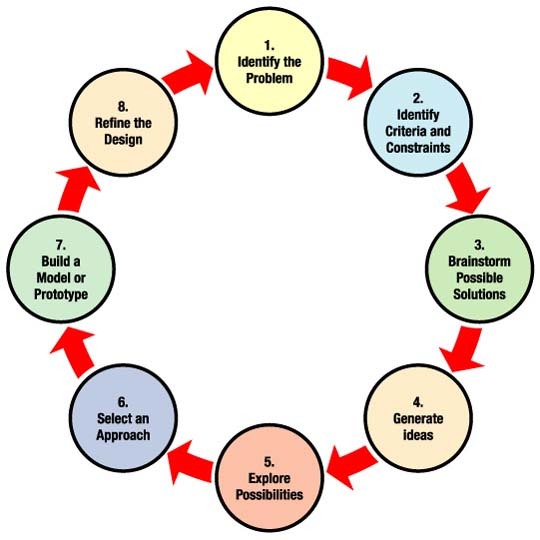
Engineering Design Process, via NASA
A painter's palette is that kidney-shaped thing you picture in one of Van Gogh's hands, a brush in his other.
Kassan has a point. If you hold your palette, your arm gets tired. If you put it down on a stool or a table, you constantly twist and hunch, from canvas to palette and back. This is no big deal over a 3-hour period, but sustain the practice over time, and you'll feel it. Kassan identified his problem around 2005. In case you don't know the name, David Kassan is one of the leading young figurative painters in the country. We'll talk about what makes his paintings so interesting another time.
Since 2005, Kassan has worked continuously to solve his palette problem. The project culminates with his current design, the Parallel Palette 2.0, for which he has run a phenomenally successful Kickstarter Campaign. I'm not going to lie to you: when I found out what he was doing, I pitched in $25 myself. I was utterly charmed. Let me explain why.
Kassan's invention is, very clearly, not a "eureka" invention. It does not invent a new field, like the printing press or the camera. Nor does it radically transform an existing field, as the iPod did to the portable music player. Rather, it represents that least glamorous, and in a sense most heroic, form of invention: the tinkerer's invention. It is focused at step 8 of the engineering design process, refining the design.
Kassan's sore back bothered him, and he began a ten-year process of fixing that problem. Each step in his solution resolved one issue, leaving others to nag at him.
His first major idea was to upend his palette and make it vertical, so that it could hang in the same plane as his canvas. He propped his kidney palette on an easel, but it kept rolling off. So he made himself a rectangular palette out of ordinary palette material - a wood sheet - and stuck a shelf on the bottom to hold a couple supplies.
This sat stably on an easel, and cleared up his back problem. It also yielded two unexpected benefits:
1. When an artist is painting from life, he or she unconsciously seeks to minimize eye movement. A shift in focus costs time and disrupts attention. A horizontal eye scan is easier and faster than a diagonal or vertical shift. When Kassan placed his subject, canvas, and palette in a horizontal line in front of him, he vastly reduced the disruption of eye scanning.
2. When he put his paint beside his canvas, the light falling on both became identical. Kassan, who is a color perfectionist, could understand in advance, for the first time, exactly what the colors he was mixing would look like on his canvas.
At this point, you will notice that Kassan has solved the problem he set out to solve. His tinkerer's impulse now comes to the fore. Although he was seeing his paint under the same light that fell on his canvas, it was sitting atop the warm color of wood. So he painted the wood the same gray he used to tone his canvases. Sadly, paint soon settled into the still-absorbant wood, rendering the cool gray much warmer.
So he built himself a new vertical palette out of dibond, an aluminum-polyethylene composite. He stuck two sheets of the stuff together, with a rectangle cut out of one to hold a glass plate. He painted the back of his glass plate canvas-tone grey, and mixed his paint on the front of it. At the end of each session, he was able to pop out the glass and wash off the leftover paint with alcohol, instead of the arduous scraping demanded by wood.
As you can see, he had also started messing with loops at the bottom to hold his little cups of medium (various paint-thinner types of liquids).
Having solved the ground-color problem with the wood, it occurred to Kassan that the design could be further improved. What if he wanted to start with a blue canvas, or a yellow one, or some other color - how would he mix his colors on the right ground then? Instead of painting the back of the glass, he reasoned, one ought to slide a matching sheet of colored paper into place behind it.
By this point, the design was so involved that Kassan teamed up with a product designer, Steve Ericson, who was able to manufacture the design professionally. The shelf reappeared at the bottom, in addition to the little loops. Ericson added a tripod connector to the back of the design, so that it could be attached to any standard tripod.
Kassan used this Parallel Palette 1.0 in his own studio and workshops, but Ericson could scarcely hand-make enough of them to meet the demand from what turned out to be an enthusiastic market. So Kassan added a second designer to the team, David Lemyre, whose expertise included scaling up to mass production.
The mass production of this most recent design, the Parallel Palette 2.0 - still being tweaked (Kassan recently expanded the glass plate) - was the point of the Kickstarter.
Like I said, this is not the story of a product that changes the world. It is the story of one artist seeking to minimize the friction between subject, eye, hand, and media. Through the patient accumulation of small improvements over a long period of time, a single pretty good idea developed into an amazing execution.
It is not useful for all oil painters. It is fairly irrelevant for those who work with extremely runny paint, or immense quantities of paint, or to those who strike their palettes hard, or fail to clean them, or don't give a whit (as I do not) about precision color mixing. And yet it stands to be a treasure to the thousands of artists and art students working today who subject themselves to technical demands similar to those Kassan places upon himself.
Kassan explains that he developed this device because he is pragmatic. But in this, I believe that he fails to understand himself. It would have been more pragmatic to put up with the back pain than to spend ten years solving a back pain problem that was resolved in the first couple of months. What he did is not pragmatic at all. Rather, it reflects a restless desire to improve the utilitarian objects with which he surrounds himself. It is the tinkerer's passion.
This is the passion I found so utterly charming, and the reason I chipped in, and found time to have Kassan walk me through the whole story. Look around you. You are surrounded by objects made by human beings. A very few of them are breakthrough eureka objects. The rest do their jobs in a humble and invisible way. The more humble and invisible they become, the better they do their jobs. This sanding down of design problems didn't just happen. It is the sum of efforts by legions of inventors and designers possessed of a passion to make things work well. There is a gladness to good invention and design, transmitted from maker to user through an object that solves a problem gracefully. That grace only comes from the passion for step 8: refining the design. With the Parallel Palette 2.0, David Kassan joins the ranks of inventors who make life gladder in this particular way, which is quiet but profound.
David Kassan online.

